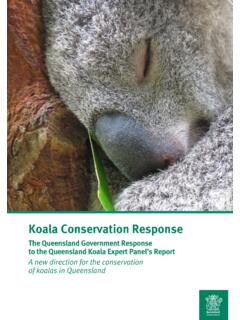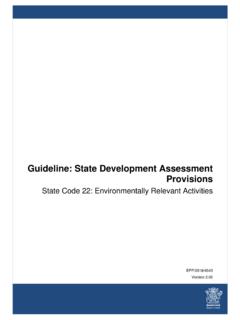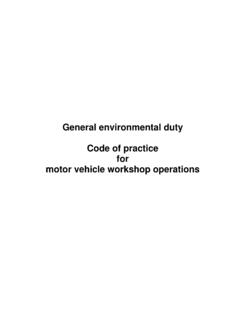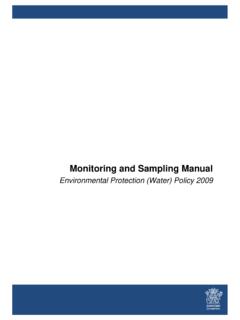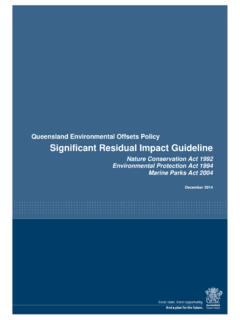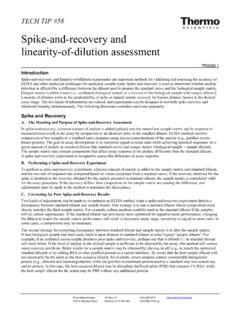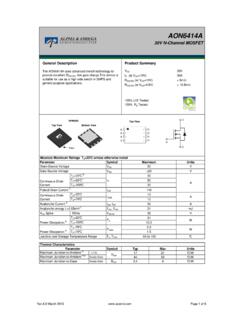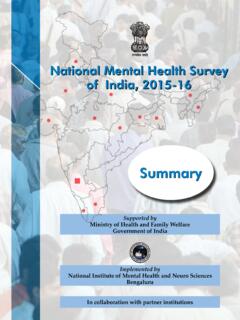Transcription of Quality control for water and sediment sampling
1 Environmental Protection ( water ) Policy 2009 - Monitoring and sampling Manual sampling design and preparation Version: February 2018 Quality control for water and sediment sampling 1 Purpose and scope This document outlines an approach for collecting control samples during a monitoring program it does not cover laboratory Quality control procedures. The collection of Quality control samples is essential in order to provide confidence in the results of a sampling program, and is part of the overall Quality assurance program. 2 Associated documents sampling design and preparation: sampling scope and design. Physical and chemical assessment: Manual collection of surface water samples (including field filtration) Background to water Quality sampling using automated sampling equipment water Quality sampling using automated sampling equipment Chlorophyll a sample collection methods Collection and preservation of sediment Guidance on the sampling of groundwaters Biological assessment: Direct toxicity assessments 3 Introduction The number and type of Quality control samples collected will depend on the type of analysis being undertaken, the number of samples being collected and the level of contamination expected.
2 For example, blank samples may be more important when assessing low levels of environmental contamination ( ultra-trace metals in water ) than when assessing industrial waste. Field Quality control samples can be used to assess and estimate: Whether a contaminant has been introduced into a sample during the sample collection, sample transport or in the laboratory analysis. The accuracy of the result. Accuracy refers to how close a result is to its true value. The precision within the results of a set of analyses. Precision relates to the repeatability of a result the closeness of the results of multiple analyses to each other. It gives no indication of a results relationship to a true value. The number of Quality control samples should be defined during the sampling design process, and acceptance criteria should be determined during this phase. Acceptance criteria are the agreed upon limits that ensure data are of acceptable Quality .
3 If the Quality control results are outside the acceptance criteria, investigations should be undertaken, and in some cases data will have to be rejected. Note: The analytical method used for the Quality control samples should be exactly the same as used to analyse other samples from the sampling program. Quality control for water and sediment sampling 2 4 Quality control samples Blanks Blanks are used to trace sources of contamination that may be introduced into a sample from the sampling process, sample transportation, or from laboratory sources of contamination. The number of blanks collected for each sampling program will depend upon the programs objectives and size, and the types and concentrations of analytes being measured. Blanks should analysed for the same analytes as all other samples. Blank water should be ultra-pure MilliQ water provided by the analytical laboratory, or if from another source routinely tested to show no contamination is present.
4 Guidance on the number of blank samples is provided in Table types of blanks are outlined below: Container blank: used to quantify and trace contamination problems associated with the sample containers and preservation. A bottle is filled with ultra-pure MilliQ supplied by the analytical laboratory, preservative is added (if required), and the sample is stored for the same time as the samples for analysis. Trip or transport blanks: used to estimate contamination of a sample from shipping and laboratory sources of contamination. A bottle is filled with ultra-pure MilliQ, preservative is added (if required), and the sample is transported using the same procedures as the samples. These blanks are generally used for assessing volatile contamination; however, it may also be appropriate to include field blanks for all analytes if using ice for shipping, and there is a chance of melted water coming into contact with sample bottles and very low levels of contaminants are being measured.
5 Field blanks: used to estimate contamination of a sample during the collection procedure. Field blanks are prepared in the field in the same manner as the sample. A bottle is filled in the field with ultra-pure MilliQ water , preservative is added (if required), and for example, if a sample is field filtered, the field blank will also be filtered. It is recommended that water is supplied by the testing laboratory, or if produced in house, undergoes testing to ensure it is contaminant free. Rinsate/Equipment blank: used where an analyte free liquid is poured over or through decontaminated field sampling equipment to assess potential contamination from the equipment. Generally, ultra-pure MilliQ water is used, but other liquids may be more appropriate ( analytical grade hexane if testing for hydrocarbons or organics). Note: Distilled water purchased from retailers is not adequate for use as a blank.
6 Other field Quality control samples Trip spikes. Particularly useful for volatile compounds. Prior to field trip, clean analyte free water spiked with a known concentration of compound of interest and taken to field and returned unopened for analysis. Duplicate or triplicates: duplicate or triplicate samples are obtained by splitting a sample into two or by taking subsamples from the collection container. They may also be collected in the field by sampling at exactly the same time and place. Duplicate results provide an estimate of the error associated with the subsampling/splitting process and laboratory analysis, and are a measure of precision. Duplicate samples should be sent in as blind samples to the laboratory. Depending upon the individual circumstances of the sampling program, it is recommended that a subset of duplicate or triplicate samples be sent to a second laboratory to confirm the primary laboratory s results.
7 Certified reference material (CRM): certified reference materials are available for some analytes in some matrixes. Certified reference material can be used to assess laboratory accuracy and precision. Samples should be sent in as a blind sample. The concentration of analytes in the CRM should be in the range of the analytes expected in the environmental samples. Note: A blind sample is a sample named so that it is indistinguishable from the other samples. This means the source and chemical composition of the samples are not known to the analyst. Blanks, duplicates and CRM are often used as blind samples. Blind samples can determine variability within a laboratory or bias and variability between two or more laboratories. Replicates: replicate samples are obtained by collecting two or more samples across a site at the same time. Quality control for water and sediment sampling 3 Replicate samples provide estimates of the sample variability, including experimental sampling error and analytical error.
8 The number of replicate samples collected depends upon the program objectives. See sampling design and preparation sampling scope and design for further information. Table 1: Guidance on the frequency of collection and purpose of Quality control samples. Quality control Sample Number of Quality control samples to be collected Notes Container Blank One per trip. Field Blank One per field team per trip or one per 20 samples. If sampling in a particularly dirty environment and for trace or ultra-trace concentrations of analytes, it may be useful to collect more field blanks ( one per team per day). Trip/Transport Blank For volatile organic contaminants (VOC) - one per cooler box. Rinsate/Equipment Blank One per field team per trip. Duplicates (triplicates) For waters: one per 10 samples for primary laboratory, one per twenty samples to the second laboratory (or one per program when there are less than 20 samples).
9 For soils: one per 20 samples. Assesses precision of the results within a laboratory and between laboratories. Trip spike For VOC one per trip. Tests the loss volatile compounds. Certified Reference Material Ad hoc. One per large sampling project. Evaluates laboratory accuracy and precision. Should be sent in as a blind sample. 5 Guidance on assessing Quality control data Quality control data should be assessed immediately upon receipt of data from the laboratory to ensure any problems indicated from the Quality control program can be investigated as soon as possible. Blanks Any reported concentrations of inorganic or organic contaminants in blanks should be investigated immediately. Collection of adequate blank data should indicate if the source of contamination is the container, equipment, field, transport or the laboratory. Duplicates The assessment of duplicates is commonly undertaken by expressing the duplicate results as the Relative Percent Difference (RPD).
10 As a rule of thumb, a RPD of 20% may indicate an acceptable result for duplicate aqueous samples (Equation 1), provided the result is five to ten times the limit of reporting (LOR). In those circumstances where the result is close to the LOR, RPD may exceed 20%. However, the acceptable RPD can be strongly influenced by the analyte and matrix. Quality control for water and sediment sampling 4 Therefore, specific acceptance criteria should be discussed with the laboratory prior to the sampling program commencing. The Australian Standard for Soils (AS ), which can be applied to sediments, gives an acceptance criteria RPD of 30-50%, noting that the variation is higher for organic than inorganic analyses. 10022121 CCCCRPD Equation 1 Where: RPD is relative percentage difference C1 is the concentration of analyte from sample 1 C2 is the concentration of analyte from sample 2. Certified reference material To assess how far away a result is from a true result using field spikes and certified reference material (CRM), the percent recovery is typically used (Equation 2).
